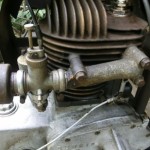Forum Replies Created
-
AuthorPosts
-
August 1, 2023 at 1:25 pm #41033
 wristpinParticipant
wristpinParticipantYour code number shows that it was made in 82 so the post 81 manual applies .
The second rod is included in the standard build engine assuming no remote throttle. If you have a cable throttle it is likely to be as per the insert illustration as in 56. – always assuming that your machine has not been re-engined. If I come across one still in place I discard it, as it serves no purpose and is just another thing to line up. The 56 illustration is about as good as it gets and is actually a fairly good representation of the set up in the metal.
When reassembling from a tank off situation , I find it best to offer up the tank without screwing it into place and then hooking up the gov spring – just gives one that little extra bit of space . With the spring hooked up insert the two manifold screws but not tight, then the single screw at the bottom of the tank bracket while there’s still a bit of wriggle room to align all three.
While you have the tank of it may be useful to put a straight edge across the manifold flange in case it’s a bit bowed due to over tightening . If so run a file over it. I always put a smear of heavy grease on both sides of the gasket and a drop of blue Loctite on the manifold screws – keeps them snug without the need/risk of over tightening. The latest version of those screws have recessed Torx heads which are far more accessible and easier for controlled tightening.
Should just say that it would be usual to fit a piano wire control cable that pushes and pulls without the need for what I would describe as a return spring but it may just be a difference in terminology.July 31, 2023 at 11:08 pm #41029 wristpinParticipant
wristpinParticipantI should add that in fig 56 of my last post, there is a rod with a letter A and a rotation symbol . That is for a “ universal” engine with no remote throttle. If yours has a cable throttle control, that rod will not be present.
July 31, 2023 at 9:50 pm #41026 wristpinParticipant
wristpinParticipantSounds like your Briggs man was less than experienced or just not interested !
The main issue is that there were several variations in the set up for the 13 series 5 Hp throttle / governor linkage. The main difference being between those with the throttle cable clamped to the carb on top of the tank and that clamped to the tank support bracket, low down by the engine base .
Worth investing in the BS manual 270962. Single cylinder L head manual – post 1981July 4, 2023 at 9:27 pm #40955 wristpinParticipant
wristpinParticipantMay just be the angle of the image but it looks as though there may be a pulley alignment issue.A pic with the belt fitted may clarify.
May 31, 2023 at 3:25 pm #40866 wristpinParticipant
wristpinParticipantAtco 8/30 could be an original Atco , in which case it will be getting on a bit and may be problematical for parts; or may be a “ modern” Atco which is a re- badged Stiga. If it has a Briggs and Stratton engine, look at the Model, Type and Code numbers on the engine and the Code will tell you it’s approximate age. ( always assuming it’s not been re- engined !!)
May 26, 2023 at 7:15 pm #40840 wristpinParticipant
wristpinParticipantNo image reaching here! However I’m guessing that either you have the wrong blades or the right ones assembled incorrectly . When there is a central gearbox the inner tines are usually curved in towards the centre to avoid leaving too wide an uncultivated strip.
May 22, 2023 at 4:46 pm #40833 wristpinParticipant
wristpinParticipantAnother oddity , 50p from a bin of assorted at a boot sale . Cheap / expensive paper weight !
I presume that it’s a flare nut spanner for pipe connectors.
Weighs 1.7 lbs.https://www.datamp.org/patents/displayPatent.php?number=17417&type=RE&country=US
May 18, 2023 at 1:04 pm #40822 wristpinParticipant
wristpinParticipantMake one from a bit of flat belting. Possibly start at an agricultural supplier or bearing and power transmission factors.
April 21, 2023 at 10:51 pm #40741 wristpinParticipant
wristpinParticipantShame to sell it , lovely and original
Yes, unmolested and useable, but there comes a time in life when it’s better that they go to someone who will enjoy them, than gathering dust in the shed.
I enjoy sorting them more than hoarding them.
There were two trailer loads where that Minor came from!April 11, 2023 at 5:55 pm #40713 wristpinParticipant
wristpinParticipantReading the above I have to admit to loosing the plot a bit. The OP would seem to know what he’s talking about but it’s as well to understand a few basics.You don’t actually mention the brands of engine , so I’m assuming Briggs.
The ignition is entirely self contained and does not require any external power ( the OP already touches on this and its expensive consequences) The only connection between the ignition coils and the ignition switch is one terminal that grounds it when the switch is off. Buried in one of the Briggs manuals is an instruction to perform 50+ on and off checks that said kill terminal never becomes live due to an internal fault.
In addition to the kill wire from the coils to the kill terminal of the switch , there may also be a diode harness connecting the two coils which stops them interfering with one another . Failure or absence of this harness can produce some strange consequence, such as running on one cylinder or continue to run on one or with the key in the off position. Again, buried in one of the manuals is a little chart giving the various combinations of symptoms from diode failures .
For what it’s worth at this stage, my best advice is – disconnect the kill wire from the coils and add your own kill wire, which by grounding, will be your only way of stopping the engine . Check out the diode harness and renew if faulty . Then fire up the engine and check that it runs on both cylinders and stops on both when your kill wire is grounded. If it performs correctly you then know that the ignition is ok.
Now don’t reconnect the original kill wire until you have ascertained that none of the alterations, additional relays etc, are introducing a spurious power feed to the ignition kill circuit.
Then with the aid of a wiring diagram, Check out the charging circuit. Note that the square box with the yellow wires is the rectifier regulator and needs 9 volts to operate . If there’s a flat battery and the machine is jump started , the machine will never charge. Start with a fully charged battery. Also note that the rectifier regulators are specific to the alternator type and capacity. Again, there are charts showing the various options of alternators and their appropriate rectifier regulators.-
This reply was modified 2 years, 7 months ago by
 wristpin.
wristpin.
April 10, 2023 at 10:42 pm #40704 wristpinParticipant
wristpinParticipantLooks as though there is a manual on line but you may have to pay for it
https://lawnandgarden.manualsonline.com/support/mountfield/lawn-mower/workshop-manual-5019379
A decent parts list may give a clue.
April 3, 2023 at 9:26 pm #40685 wristpinParticipant
wristpinParticipantFor “genuine” read “of the correct spec for the application”. If the job requires a Kevlar or Aramid belt it’s penny foolish to fit anything of lesser quality . Unless one wants to practice belt changing!
March 26, 2023 at 9:19 pm #40654 wristpinParticipant
wristpinParticipantStuart Turner are still in business , have you asked them?
March 20, 2023 at 2:36 pm #40623 wristpinParticipant
wristpinParticipantI’ve used PIX from Simply Bearings on smaller machines and they’ve been fine, and SB are a good firm to deal with . Unless anyone knows from personal experience that the PIX is no good, and it looks dimensionally correct , I’d be inclined to take a punt. If when it arrives, it’s obviously incorrect, my experience is that SB will take it back.
,March 14, 2023 at 3:01 pm #40600 wristpinParticipant
wristpinParticipantWhat part of the country are you in? It does seem that the only galvaniser within fifty miles is only interested in truck loads of railings and structural steel etc.
As said for powder coating, not suitable for decks and most of the rest on a ride-ons. Once the moisture and consequent rust has penetrated and crept under it, the pressure washer brings it off in sheets. UK manufactured stuff was particularly bad ; US stuff was a bit more durable, but perhaps my experience (1980 – 2012) is a bit dated now. -
This reply was modified 2 years, 7 months ago by
-
AuthorPosts






